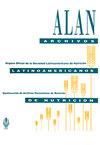Main changes on the polyphenols profile and antioxidant capacity in Manila mango (Mangifera indica L.)
IF 0.3
4区 医学
Q4 NUTRITION & DIETETICS
引用次数: 3
Abstract
Mango is the second most commercialized tropical fruit in the world, and Mexico is the major exporter. In terms of mango production, Manila´s variety represents a quarter of the total mangoes production in Mexico. However, the changes that occur on the phenolic compounds during the Manila mango ripening process are unknown. Quantitative analysis of the major phenolic compounds was conducted at different maturity stages, using several spectrophotometric measurements and by high-performance liquid chromatography (HPLC). At the late ripening stage was observed the biggest content in pulp and peel of total phenols (577 and 10547 mg EAG /100 g), flavonoids (95.33 and 537 mg EQ/100 g), and antioxidant capacity by DPPH (25 and 347 mmol TE/100 g). Some bioactive compounds achieve their highest values at optimal consumption ripening. Although they diminish when the fruit reaches a senescence appearance. This is the first study to prove that mangiferin by itself shows a higher correlation in antioxidant capacity compared to other phenolic compounds in mango peel, and this suggest that phenolic compounds may have an important role in the postharvest antioxidant metabolism in Manila mango fruit. On the other hand, the results show that the peel compared to the pulp contains higher amounts of total phenols, flavonoids, gallic acid, mangiferin and antioxidant capacity, so its use as an ingredient in the preparation of functional food products is recommended. More studies are needed to go in-depth in the changes of the content of phytochemicals during the ripening process in the peel and pulp mango, which ones could be caused by the hormones responsible for ripening in the fruit, such as ethylene, and bioavailability of these compounds at different stages of maturation. El mango es la segunda fruta tropical más comercializada del mundo y México es el principal exportador. En términos de producción de mango, la variedad Manila representa una cuarta parte de la producción total de mangos en México. Sin embargo, se desconocen los cambios que ocurren en los compuestos fenólicos durante el proceso de maduración del mango Manila. El análisis cuantitativo de los principales compuestos fenólicos se realizó en diferentes etapas de madurez, utilizando varias medidas espectrofotométricas y mediante cromatografía líquida de alta resolución (HPLC). En la etapa de madurez tardía se observó el mayor contenido en pulpa y cáscara de fenoles totales (577 y 10547 mg EAG / 100 g), flavonoides (95.33 y 537 mg EQ / 100 g) y capacidad antioxidante por DPPH (25 y 347 mmol TE / 100 g). Algunos compuestos bioactivos alcanzan sus valores más altos en el punto de madurez óptima. Aunque disminuyen cuando el fruto adquiere una apariencia de senescencia. Este es el primer estudio que demuestra que la mangiferina por sí misma presenta una alta correlación con la capacidad antioxidante en comparación con otros compuestos fenólicos de la cáscara de mango, y esto sugiere que los compuestos fenólicos pueden tener un papel importante en el metabolismo antioxidante postcosecha en el mango Manila. Por otro lado, los resultados muestran que la cáscara comparada con la pulpa contiene mayores cantidades de fenoles totales, flavonoides, ácido gálico, mangiferin y capacidad antioxidante por DPPH, por lo que se recomienda su uso como ingrediente en la elaboración de productos alimenticios fucionales. Se necesitan más estudios para profundizar en los cambios del contenido de fitoquímicos durante el proceso de maduración en la cáscara y pulpa del mango, los cuáles podrían ser provocados por las hormonas responsables de la maduración en el fruto, como el etileno, y la biodisponibilidad de estos compuestos en diferentes etapas de maduración.马尼拉芒果多酚含量及抗氧化能力的主要变化
芒果是世界上第二大商业化的热带水果,墨西哥是主要出口国。就芒果产量而言,马尼拉的芒果品种占墨西哥芒果总产量的四分之一。然而,马尼拉芒果成熟过程中酚类化合物发生的变化尚不清楚。采用分光光度法和高效液相色谱法对不同成熟度的主要酚类化合物进行了定量分析。熟后果肉和果皮中总酚含量最高(577和10547 mg EAG /100 g),总黄酮含量最高(95.33和537 mg EQ/100 g), DPPH抗氧化能力最高(25和347 mmol TE/100 g),部分活性物质在最佳消耗熟时达到最高。虽然它们减少时,果实达到衰老的外观。这是第一个证明芒果苷本身在抗氧化能力方面比芒果皮中其他酚类化合物具有更高的相关性的研究,这表明酚类化合物可能在马尼拉芒果果实采后抗氧化代谢中起重要作用。另一方面,果皮中总酚、类黄酮、没食子酸、芒果苷的含量和抗氧化能力均高于果肉,建议作为功能性食品的原料使用。芒果果皮和果肉在成熟过程中植物化学物质含量的变化,可能是由果实中负责成熟的激素(如乙烯)以及这些化合物在不同成熟阶段的生物利用度引起的,需要进一步深入研究。芒果是第二热带水果más世界商业芒果是主要出口国。所有的芒果、芒果和马尼拉均代表所有的芒果、芒果总数和芒果。在禁运中,我们发现,在我们的电脑上,我们的电脑上发生了许多变化fenólicos durante el process de maduración del mango Manila。El análisis quantiativo de los principales compuestos fenólicos se realizó en different etapas de madurez, utilizdo varias medidas espectrofotomsamtricas y mediante cromatografía líquida de alta resolución (HPLC)。En la etapa de madurez tardía se observó el mayor contenido En pulpa y cáscara de fenoles totales (577 y 10547 mg EAG / 100 g),黄酮(95.33 y 537 mg EQ / 100 g),抗氧化剂ppph (25 y 347 mmol TE / 100 g)。Algunos compuestos bioactivos alcanzan sus valores más altos En el punto de madurez óptima。独特的年龄和年龄是不同的。Este es el primer estudio que demustre que la mangiferina por sí misma presenta alta correlación con la capacidad oxidante en comparación con otros compuestos fenólicos de la cáscara de mango, y to sugiere que los compuestos fenólicos pueden tener un paper important en el metabolismo oxidante postcosecha en el mango Manila。总理最大化,洛杉矶resultados muestran乘缆车药鼠李comparada con la pulpa "应至少cantidades de fenoles完全,类黄酮,它是galico,芒果苷y capacidad antioxidante DPPH,运动,一般建议苏uso科莫ingrediente en la elaboracion de或alimenticios fucionales。Se necesitan mas工厂化对位profundizar en洛卡:德尔contenido de fitoquimicos杜兰特el proceso de maduracion en la药鼠李y pulpa del芒果,洛杉矶哪种podrian ser provocados超过拉斯维加斯hormonas负责的de la maduracion en el fruto科莫el etileno y de且这些compuestos en la biodisponibilidad不同etapas de maduracion。
本文章由计算机程序翻译,如有差异,请以英文原文为准。
求助全文
约1分钟内获得全文
求助全文
来源期刊
CiteScore
0.50
自引率
0.00%
发文量
31
期刊介绍:
Archivos Latinoamericanos de Nutrición (ALAN) is the official publication of the Sociedad Latinoamericana de Nutición (SLAN), for the dissemination of knowledge in the fields of food and nutrition, principally throughout the American Hemisphere. Articles in Spanish, English, Portuguese and French are accepted, both from the Society members and from nonmembers, in the following categories: 1. General articles (critical scientific reviews); 2. Research articles (originals); 3. Papers in applied nutrition (analytical results from intervention programs and discussion of reconmendations of practical application), and 4. Letters to Editor (short comments of general interest or about scientific facts and results previously published in Archives).

 求助内容:
求助内容: 应助结果提醒方式:
应助结果提醒方式:


